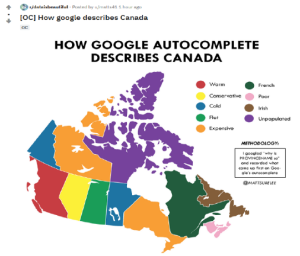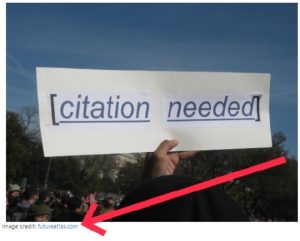8 Acknowledging information / Cite anyone?
Why We Cite
Some genres require citations, or evidence to support your claims,
while other do not.
In our everyday life, we often point out when we’re talking about someone else’s ideas. When we engage in conversations with other people, we might say things like, I watched a TikTok …” or “My advisor told me that…” When we do this, we not only give credit to the originator of the idea, but we also give more credibility to what we’re saying by letting others know the origin of the information. By doing this, you are creating new knowledge; passing on information so others can add to it. This 2009 “Friends and Family” commercial from Verizon illustrates how support grows.
Watch the Video:
In Texas, perhaps you have taken a standardized test where you were asked to ‘pretend’ that you were using source information to back up a statement. Did this really provide you with any warm and fuzzies as to why you had to acknowledge the material you were using. And isn’t this especially true on the internet, where information is frequently cut-and-paste from one site to another and anonymous authorship is the norm. It’s nearly impossible to find the origin of a viral meme online, and famously difficult to track the flow of information on social media. Stock photos pop up again and again in various contexts, and identical life-hacks and listicles appear on multiple websites. Except where it violates copyright law or a website’s policies, very little of this re-use is a problem in and of itself. By nature, the internet and social media encourage sharing, repurposing, and reposting. The idea of spreading information is how this textbook came about. There is a movement for making textbooks more affordable, so textbook creators are using a sharing copyright. Creative Commons licensing allows folks to freely use and adapt works.
Because internet culture plays so fast and loose with authorship and sourcing, academic standards for using others’ ideas can seem overly harsh or hairsplitting in comparison. As we’ll see, however, taking responsibility for one’s own work and giving credit for others’ work is one of the core ideals of the academic discourse community.
Academic Standards for Using Source Material
Academic research allows us to gain perspectives and understandings from other people through what we read, watch, and hear. In academic work we must tell our readers who and what led us to our conclusions. Documenting our research is important because people rely on academic research to be authoritative, so it is essential for academic conversation to be as clear as possible. Documentation for clarity is a shared and respected practice, and it represents a core value of the academy called “academic integrity.”1
Academic integrity can also be thought of as credibility. How credible is the document? Whether it is an ‘essay,’ a research report, or a business perspective. How do you convince your reader that the information you are providing is trustworthy? Well, you situate your work in the conversation by incorporating source material, or ‘stand on the shoulders of giants.’ Another part of establishing credibility through incorporating source material is properly acknowledging (citing) the source. If your citations are incorrect, then your reader may question the correctness of all the information in your work.
What Is Academic Integrity?
Different universities have different definitions of academic integrity. These are often spelled out in the academic handbook under a heading such as “Academic Honesty Policy” or “Academic Integrity.
Texas A&M University-Corpus Christi defines academic integrity in terms of plagiarism, found in the Student Code of Conduct, as follows:
- Plagiarism: presenting the work of another as one’s own without proper acknowledgement of the source or reusing your own work without citation. An exception exists for information that is generally accepted as common knowledge.
- Using another’s work from print, web, or other sources without acknowledging the source.
- Quoting from a source without citation.
- Using facts, figures, graphs, charts, or information without acknowledgement of the source.
- Using a past assignment(s) the student has completed as a portion of a new assignment(s), without providing citation. Please note that without instructor permission this is also considered a multiple submission violation.
According to this definition, academic integrity means taking full responsibility for your work, acknowledging your own efforts, and acknowledging the contributions of others’ efforts. Working and writing with integrity requires accurately representing what you contributed, as well as acknowledging how others have influenced your work.
Taking Responsibility for your Own Work
In the academic context, taking responsibility for your own work means that you stand by the quality of the information you pass on to others. Responsible use of information means not knowingly sharing false data, falsified results, or misinformation.
Any academic work you turn in should accurately reflect your knowledge, skills, and effort—in other words, cheating on a test or taking credit for a group project you skipped out on would both be violations of academic integrity.
Taking responsibility for your work also means being mindful, attentive, and informed about the way you use language to communicate; at the very least, avoiding statements that express or imply ideas that are sexist, racist, or otherwise biased, prejudiced, or denigrating to any group of people.
Citing AI
While it may seem that Chat GPT and other generative AI models produce “credible and reliable” sources, it is well-known that so far, these models will make-up sources and then cite them as if they exist. It is therefore imperative that researchers thoroughly check all sources “cited” by generative AI. This type of scrutiny should also be exercised when using paraphrases or summaries of these sources generated by AI. It is still more beneficial and scholarly to read the sources and summarize the material yourself. The newest generative AI models like Gemini will give you a stable URL to the prompt and the answer for you to check the credibility of your sources.
Giving Credit for Others’ Work
If you give credit where credit is due, using information from others to support your own thoughts, opinions, and research findings is good practice. Not only does it acknowledge the hard work of others, but it also shows that you did your research on the topic, you know what information exists about it, and you can integrate your knowledge into the existing research and contribute to the scholarly conversation.
The following hyperlink will take you to a video by NC State University Libraries that has a great summary of what citations are and why we use them. Citation, A Very Brief Introduction.
Informal Citations….I cite, you cite, we all cite.
Speaking of avoiding plagiarism and attributing where you get information from, have you ever thought about how this practice happens every day around you? It does! One example would be if you cite song lyrics from Taylor Swift’s new album “The Tortured Poets Department.” You and your friends would be chilling, and you said:
“Hey, did you hear the lyrics, “Now, pretty baby, I’m runnin’ back home to you;
Frеsh out the slammer, I know who my first call will be to.”
Well, now you have used an informal citation! You acknowledged something that was not of your own creation.
In real life, you’re not going to include a formal citation in an email to your cousin. However, you might link to a news article backing up a claim you make in that email. We call these informal citations, or “blog style” citations. Really, something as simple as a link to an article in an email is an informal citation.

Informal citations allow everyone to cite their sources in less formal forms of writing, like blog posts, emails, news articles, and webpages. Informal citations are how everyday creators of information acknowledge ownership, attribute quotes, check facts, and learn more. The beauty of informal citations is that they force you to think about how your sources fit, and actually say why you’re sharing them. (Those are skills that you also need to write more formal research assignments!!) You see informal citations all the time. Some examples:
| Table 1 Examples of Informal Citations | ||
| News Informational Citation | Infographic Informal Citation | Webpage Image Informal Citation |
| “‘Forever 21 is a powerful retail brand with incredible consumer reach and a wealth of untapped potential,’ Jamie Salter, CEO of ABG, said in a statement(opens in new window). Forever 21 currently has 593 stores globally.” |
 |
 |
| Source: NPR(opens in new window) |
Screenshot source: |
Screenshot source: LIB101 Week 4 splashpage |
| Explanation: In the text of their news article, NPR is citing and linking readers to where CEO Salter said the quote. | Explanation: Redditor matts41 cited their data- gathering methodology in the image | Explanation: CCC librarians are citing the source of the image by including a link to the source. |
The main takeaway – citing your sources is important no matter how or where you are sharing information.
Tips for informally citing sources Informal citations work well for short pieces with a small number of sources and no formal citation requirement, reflections, and/or Moodle forum posts. Make sure you provide enough information for the source so that it can be found in a Google search.
- Google docs
- Word docs
- Moodle forums[1]
So, citations are all around us. Whether you are informally citing Taylor Swift, linking to a cool new product, or using academic sources to add credibility to a research article or five-million-dollar contract proposal, you are using and acknowledging the work of others.
Licenses and Attributions
Why We Cite Sources. Authored by: Walter D. Butler, Aloha Sargent, and Kelsey Smith. Located at: https://introtocollegeresearch.pressbooks.com/chapter/why-we-cite-sources/. Project: Introduction to College Research. License: CC BY: Attribution
CC Licensed Content, Shared Previously
Ethical Use and Citing Sources. Provided by: Teaching & Learning, State University Libraries. Located at: https://ohiostate.pressbooks.pub/choosingsources/chapter/ethical-use-and-citing-sources/. Project: Choosing & Using Sources: A Guide to Academic Research. License: CC BY: Attribution
Why We Cite Sources. Authored by: Walter D. Butler, Aloha Sargent, and Kelsey Smith. Located at: https://introtocollegeresearch.pressbooks.com/chapter/why-we-cite-sources/. Project: Introduction to College Research. License: CC BY: Attribution
License: CC BY-NC-SA: Attribution-NonCommercial-ShareAlike
Academic integrity. Provided by: Lumen Learning. License: CC BY: Attribution
Citations IRL (in real life) is shared under a CC BY-NC, was authored, remixed, and/or curated by Clackamas Community College Library.
Media Attributions
- itt email
- image5
- image6
- Moodle is an open source Learning Management System (LMS) not typically in use at TAMUCC at this time ↵

